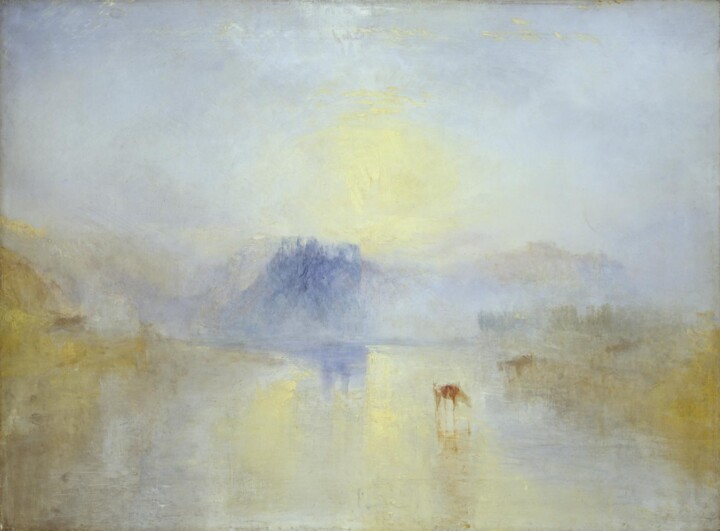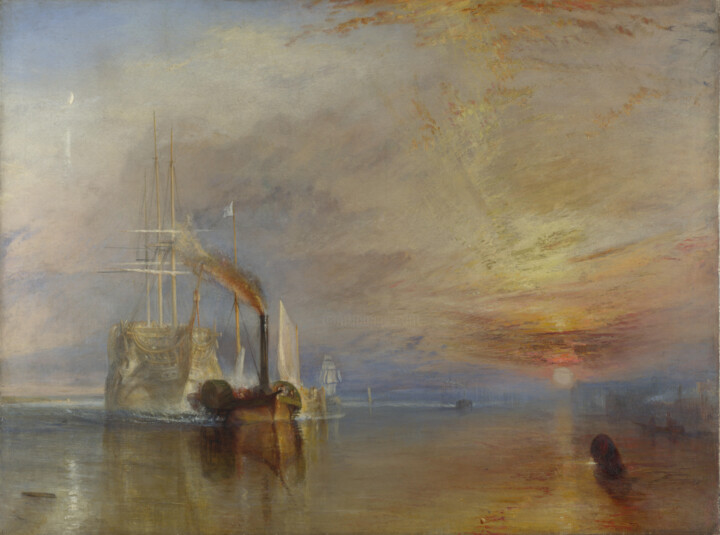 J. M. W. Turner - Fishermen at Sea, 1796. Oil on canvas. 91.4 x 122.2 cm. Tate Gallery, London
J. M. W. Turner - Fishermen at Sea, 1796. Oil on canvas. 91.4 x 122.2 cm. Tate Gallery, London
Who was J. M. W. Turner?
Joseph Mallord William Turner (1775-1851) was an English artist who is widely considered to be one of the greatest landscape painters in the history of Western art. He is known for his distinctive style that emphasized light, color, and atmosphere, and for his ability to capture the beauty and power of nature.
Turner was born in London and showed an early talent for drawing and painting. He began exhibiting his work at the Royal Academy of Arts when he was just 15 years old, and he went on to become a member of the Academy in 1802. Throughout his career, Turner traveled extensively throughout Britain and Europe, and his paintings often depicted famous landmarks and landscapes from these places.
Turner's work was highly innovative for its time, and he experimented with new techniques and styles throughout his career. He was particularly interested in the effects of light and color, and he often used bold, expressive brushstrokes to create dramatic and atmospheric landscapes. Some of his most famous works include "The Fighting Temeraire", "Rain, Steam and Speed", and "Snow Storm: Steam-Boat off a Harbour's Mouth".
Today, he is considered one of the most important artists of the Romantic era and his work is celebrated for its beauty and its influence on the development of modern art.
 J. M. W. Turner, painted from memory by John Linnell, 1838. Oil on canvas. 46 x 38.4 cm. National Portrait Gallery, London
J. M. W. Turner, painted from memory by John Linnell, 1838. Oil on canvas. 46 x 38.4 cm. National Portrait Gallery, London
J. M. W. Turner and British Romanticism
Joseph Mallord William Turner is considered one of the key figures of the British Romantic art movement. Romanticism emerged in the late 18th century as a reaction against the Enlightenment emphasis on reason and science. Romantic artists like Turner were more interested in emotion, imagination, and the power of nature.
Turner's paintings are characterized by their dramatic and atmospheric depictions of natural landscapes, seascapes, and storms. His use of light and color to create mood and convey emotion was particularly innovative and influential. Turner's fascination with nature was often expressed in his paintings, which frequently depicted the power and beauty of the natural world, as well as its potential to inspire awe and wonder.
In addition to his innovative techniques and subject matter, Turner was also known for his interest in history and mythology, which he often incorporated into his paintings. Many of his works explore themes of heroism, sacrifice, and the struggle for freedom, all of which were central concerns of the Romantic movement.
JMW Turner's contributions to British Romanticism were significant, and his influence can be seen in the works of many later artists. He helped to transform landscape painting from a relatively straightforward depiction of the natural world into a powerful expression of human emotion and imagination.
“Fishermen at Sea”
The first painting by J.M.W. Turner is not definitively known, as he created many works throughout his early career. However, one of his earliest known paintings is believed to be "Fishermen at Sea," completed in 1796 when Turner was just 21 years old and was still establishing himself as an artist.
The painting depicts two fishermen in a small boat battling against the powerful waves and gusting winds of a stormy sea. The painting is notable for its dramatic and atmospheric depiction of the sea, with swirling clouds and waves creating a sense of movement and chaos. Turner's use of light is also particularly striking in this painting, with the moon illuminating the scene and casting an eerie glow over the waves and the fishermen's faces.
"Fishermen at Sea" was a departure from the more traditional and picturesque style of landscape painting that was popular at the time, and it marked the beginning of Turner's lifelong fascination with the power and drama of nature. The painting was also an early indication of Turner's mastery of light and atmosphere, which would become defining features of his later works.
The painting's bold and dramatic style marked a departure from traditional landscape painting and helped him to establish as a rising star in the British art world, and paved the way for Turner's later innovations in art.
Today, "Fishermen at Sea" is considered to be one of Turner's most important early works and is held in the collection of the Tate Britain museum in London.
Criticism
"Fishermen at Sea" received both praise and criticism when it was exhibited at the Royal Academy in 1796. One of the most enthusiastic endorsements came from the influential art critic and writer John Ruskin. Ruskin admired Turner's ability to capture the power and unpredictability of nature, and believed that "Fishermen at Sea" was a prime example of the artist's genius.
Those who appreciated Turner's work tended to be drawn to the emotional power and intensity of his paintings, as well as his willingness to experiment with new techniques and subject matter. Many saw "Fishermen at Sea" as a bold and innovative work that pushed the boundaries of traditional landscape painting and opened up new possibilities for artistic expression. In general, some critics were impressed with Turner's skillful handling of light and atmosphere, and praised the painting for its sense of drama and immediacy. Others, however, were less impressed, and criticized the painting for its unconventional subject matter and lack of clear narrative.
One of the main criticisms of "Fishermen at Sea" was that it lacked the classical idealization and carefully composed landscapes that were popular at the time. Some critics found the painting too chaotic and unstructured, and questioned whether it could even be considered a landscape at all.
Despite these criticisms, however, "Fishermen at Sea" was a popular and influential work that helped establish Turner as one of the leading artists of his generation. The painting's innovative use of light and atmosphere, combined with its depiction of the power and unpredictability of nature, would go on to inspire many other artists in the years to come. Today, "Fishermen at Sea" is recognized as an important early work in Turner's career, and is widely regarded as a masterpiece of British Romanticism.


 Selena Mattei
Selena Mattei





